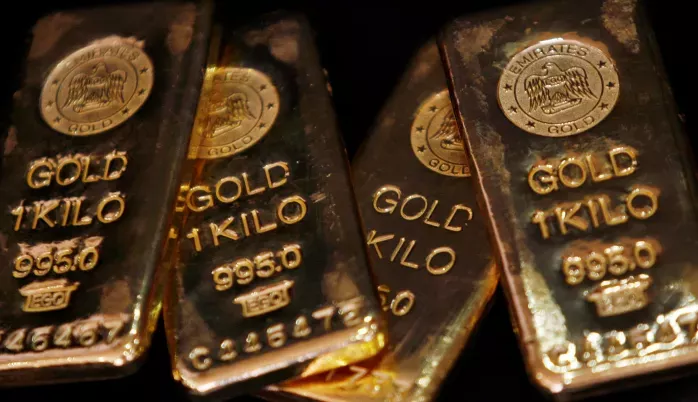Gold prices surged to an all-time high on Monday, bolstered by increasing safe-haven demand as concerns over inflation and economic growth escalated due to U.S. President Donald Trump’s tariffs on Canadian, Chinese, and Mexican imports. The impact of these tariffs, and the fears of a resulting trade war, created a sense of economic and geopolitical uncertainty that prompted investors to flock to gold, traditionally seen as a stable store of value during times of crisis.
Spot gold rose by 0.8% to $2,818.99 per ounce by 01:45 p.m. ET (1845 GMT), peaking at an all-time high of $2,830.49 earlier in the session. The price increase followed a consistent upward trend, with U.S. gold futures settling at $2,857.10 per ounce, also up by 0.8%. This price movement highlights how the gold market is reacting to fears of a trade war and the inflationary pressures that could arise from such a situation.
David Meger, director of metals trading at High Ridge Futures, emphasized the role of uncertainty surrounding Trump’s tariffs in driving gold’s rally. Despite the U.S. dollar’s usual dampening effect on gold prices, the tariff announcements fueled a surge in demand for the yellow metal. The tariffs, which include a 25% levy on Canadian and Mexican imports and a 10% charge on Chinese goods, stoked fears of a trade war that could potentially derail global growth while simultaneously stoking inflation. These fears of economic disruption prompted investors to turn to gold as a safe-haven asset, as they sought to shield their portfolios from potential market shocks.
In retaliation, both Canada and Mexico announced their own measures, while China indicated that it would challenge the tariffs at the World Trade Organization (WTO) and pursue countermeasures. This escalating trade dispute, compounded by uncertainty surrounding the geopolitical landscape, contributed to the surge in gold prices. However, U.S. President Trump also announced a temporary pause on the tariffs imposed on Mexico, which has added another layer of complexity to the evolving situation.
Despite this pause, there remains significant concern in the markets about the long-term implications of the tariffs and the potential for a global trade war. Bart Melek, head of commodity strategies at TD Securities, noted that the market hasn’t yet fully responded to the trade war, but should tensions persist for an extended period, it could result in a major upward shift in gold prices. Investors are closely monitoring these developments, as the risk of economic slowdown and inflation continues to escalate.
The gold market is no stranger to fluctuations driven by geopolitical and economic instability. Historically, gold has been viewed as a safe-haven investment during periods of crisis, offering protection against inflation, currency devaluation, and market volatility. As such, the ongoing trade tensions have made gold even more appealing to investors, leading to a steady climb in its value.
In addition to the tariffs and trade concerns, analysts are closely watching upcoming U.S. economic data, including job openings, the ADP employment report, and the official U.S. employment report, which could offer further insight into the state of the U.S. economy. Strong employment data may indicate a robust economy, which could influence gold’s price movement. Conversely, weaker-than-expected data may increase the demand for gold as investors seek shelter from potential economic risks.
Amidst the growing demand for gold, bullion banks have been taking steps to capitalize on the high demand by transporting gold from Asian trading hubs, such as Dubai and Hong Kong, to the U.S. These gold shipments are motivated by the unusually high premium for U.S. gold futures over spot prices, providing an opportunity for significant profits. This shift in gold trading patterns further underscores the strength of demand for gold in the current market environment.
In the broader precious metals market, there were mixed results. Spot silver rose by 0.8%, reaching $31.56 per ounce, benefiting from the safe-haven rally. On the other hand, platinum experienced a decline, losing 1.5% to $963.40 per ounce, while palladium saw a modest gain of 0.5%, closing at $1,012.85 per ounce. The fluctuating fortunes of these metals reflect the varying levels of investor sentiment across different sectors of the precious metals market, with gold continuing to lead the way as the favored asset in times of uncertainty.
As the situation evolves, analysts remain cautious but optimistic about gold’s potential to continue its rally. Some observers, including J.P. Morgan, have highlighted the potential for a medium-term bullish trend, driven by the ongoing geopolitical uncertainty and inflationary risks. Meanwhile, others like Goldman Sachs and Eric Strand of AuAg Funds forecast that gold could exceed $3,000 per ounce by the end of 2025, with some even speculating that it could reach as high as $3,300.
In conclusion, while the immediate future for gold is shaped by the ongoing trade tensions and global economic uncertainty, the outlook for the precious metal remains strong. Investors seeking to hedge against inflation and instability are likely to continue driving demand for gold, making it a valuable asset in the current market environment. Whether through direct investment in gold, gold ETFs, or gold mining stocks, the diverse ways to gain exposure to gold ensure that it remains a key component of many portfolios as investors navigate an increasingly uncertain global landscape.
Related topics:
Gold Prices Rebound After Fed Rate Cut Comments
Gold Prices Surge In 2024: What Will Investors Face In 2025?
Auric Mining Sells Jeffreys Find Gold For $5.2 Million

